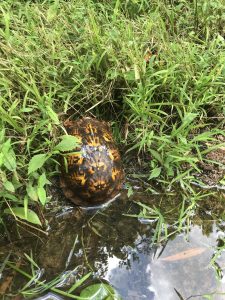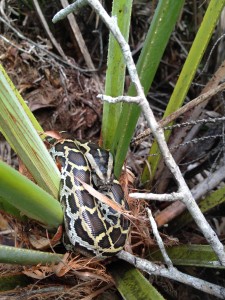Movement Ecology

As anthropogenic disturbance causes rapid changes to our planet, our ability to prevent or minimize damage hinges on predicting or anticipating these changes. Individual-level movement is an important manifestation of and vehicle for ecosystem change and therefore can provide concrete insight into the complex ways that ecosystems respond to anthropogenic disturbances.
My students and I ask original research questions with an emphasis on amphibians and reptiles such as:
- How do individuals decide when and how to move?
- What characteristics of movement paths impact population spread or persistence?
- What internal factors (such as age or previous experience) and external factors (such as climate or habitat) influence movement decisions and their survival or fitness consequences?
We use a combination of field studies, laboratory experiments, and simulation and statistical modeling to investigate the proximate and ultimate causes of movement and the consequences of movement to populations, communities, and ecosystems in changing landscapes.
My goal is to conduct research that adds to basic knowledge about our environment, that has practical applications that can be used to improve our world, and that provides exciting research opportunities for students. I therefore aim for my research to address both theoretical and applied questions in biology. The research questions that I find most intriguing and tractable traverse taxonomic boundaries: I have studied pond-breeding amphibians, exotic perennial grasses, treefrogs, Burmese pythons, pond turtles, among others. My overarching goal is to explore how individual-level movement in response to spatial and temporal patterns in resources and risk impacts persistence.
Invasive Species
Although considerable mathematical theory has been devoted to modeling rates of spread of invasive species, many complex models nevertheless simplify two of the most critical determinants of spread dynamics: movement behavior and landscape composition. Preventing or managing invasions necessitates an understanding of how organisms behave in response to habitat or landscape features. My lab is currently studying the landscape-level movement and dispersal of Burmese pythons. I use a combination of field experiments and individual-based modeling to determine the influence of movement behavior on Burmese python invasive population spread in South Florida. This research provides insight into factors influencing the dynamics of the geographic spread of species, with implications for invasive species control, prediction of species’ range shifts resulting from climate change, the spatial dynamics of species in changing landscapes, and a mechanistic understanding of observed species’ ranges.
Conservation of Pond-breeding Amphibians
Just as movement can offer insights into species spreading into new areas, it can also provide insight into how species persist when habitat is lost or changed. Human-induced habitat change is widely regarded as a primary factor threatening the persistence of species. One major consequence of habitat alteration is its effect on the movement behavior of individuals. Animal movement is often strongly influenced by habitat type; knowledge of the strength, direction, and variation inherent in species’ behavioral reactions to novel or altered habitat is crucial for identifying the mechanistic causes of population or metapopulation dynamics, and for maximizing the effectiveness of conservation and management practices. Natal dispersal is an important mechanism by which species mitigate the effects of unpredictable variation in the spatial distribution of resources and is critical to many species’ spatial dynamics. Habitat alteration impacts the spatial patterning of resources and the risks associated with searching for resources. My lab uses a combination of empirical studies of juvenile amphibian movement and individual-based modeling to investigate the influence of habitat amount and arrangement on the persistence of pond-breeding amphibian populations.
